Mumbai: For the last 24 years, police clerk Deepika Sawant* has been living in a 180-sq ft flat, barely the size of four ATM kiosks put together, in a police colony adjoining the Saki Naka police station in Andheri, a west Mumbai suburb.

Sunita Lokhande* and Sudha Kamble* stand in the corridor one floor above their flats in the Saki Naka police housing complex. Three buildings in the complex have been declared unsafe by the PWD.
In July this year, water seeped into her third-floor flat, damaging her TV, ceiling fan and her bed. “It was like a waterfall inside our house,” Sawant said, “There was water coming in through every corner of the house. We did not know what to do.”
Sawant along with her husband and daughter then had to move into an empty flat on the first floor of the same building. The Sawants are among the only three families currently living in this building, which along with two other blocks were declared unsafe by the public works department (PWD) after a structural audit. The PWD had issued an eviction notice to the residents of the building where Sawant lives in 2017 and for the other two blocks in 2019.
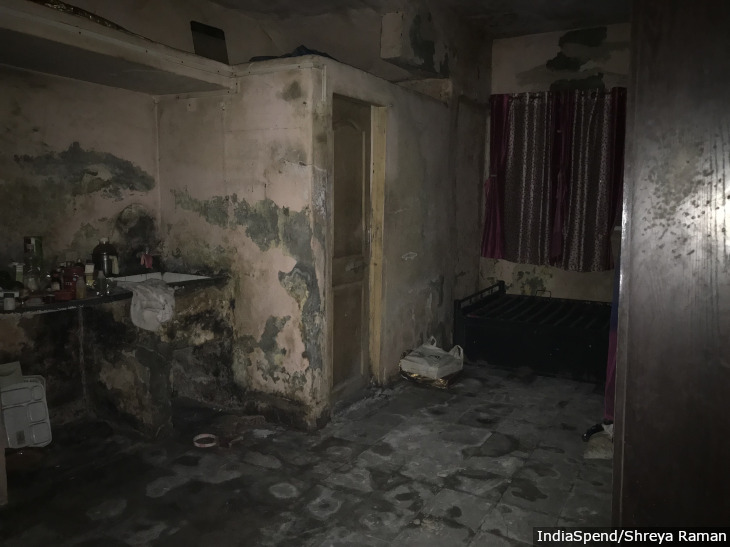
The third floor house in the Saki Naka police-department complex where the Sawants lived. One night, water seeped in from all corners of the ceiling–ruining the walls and the floor of the house.
Those living in the unsafe buildings were allotted alternative flats in Jogeshwari, 10 km away. But the new flats are much smaller–a balcony knocks 20 sq ft off their living area, Sawant complained. And the alternative allotments were only made only a year ago, she added.
“Last year they allocated us rooms in the adjacent wing of the same building and in June (2019), they gave notice to the residents of those wings too,” Sawant said, “We are not encroachers, we are public servants. All we are asking for are appropriate housing alternatives.”
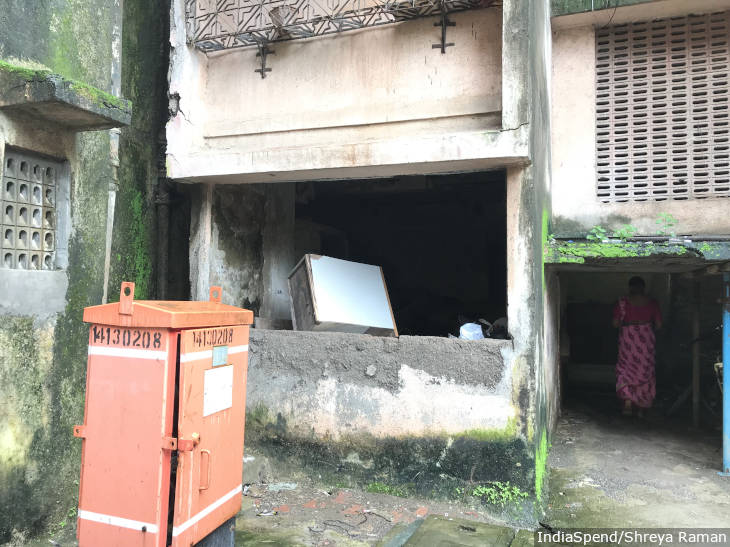
The rooms on the ground floor of Wing C of the Saki Naka police-department housing complex. Parts of the ceiling and walls have caved in. However, police personnel and their families continue to live on the higher floors.
The problems faced by Sawant and her neighbours are not unique to Mumbai. There are not enough houses for India’s police personnel and those who do have accommodation are highly dissatisfied with it, said a recent report by the Bureau of Police Research & Development (BPRD). As of 2017, only 592,406 family houses were available for the police, enough to accommodate just 29.7% of the 1,989,295 civil and armed police personnel.
Of those who have official accommodation, over three in four (75.96%) personnel are not satisfied with it. The percentage level of satisfaction has been consistently decreasing in the 10 years leading to 2016. From 2006 to 2016, the percentage dropped by 6.05 percentage points from 30.09% to 24.04%.

The level of satisfaction is the highest (28.47%) among high-ranked gazetted officials–those between the ranks of director-general of police and deputy superintendent of police. It is the lowest (22.22%) among mid-level officials who are between the ranks of inspector and assistant sub-inspector. The constabulary fall somewhere in the middle at 24.3% being satisfied with their accommodation.
The lowest ranked and the least paid, the constabulary forms the majority of the police force. In a force of 1.98 million, 47.7% (949,011) are constables and 17.95% (357,273) are head constables–a combined 65.6%.
The government has been aware of the need to provide quality housing for the police personnel for over four decades now. In 1977, the government constituted a National Police Commission and its first report pointed out that this need had to be dealt with urgently, especially for those in the constabulary.
“The importance of providing accommodation to the constabulary, who have to perform long and arduous hours of work, who have to be available for taking up duties on a 24-hour-call and who, on some occasions, have literally to be on duty continuously without any relief in a 24-hour period, has also been recognised by the various State Police Commissions and is reflected in the general policy of the State Governments and the Government of India in this regard,” said the report. “We, however, find some serious failings in the implementation of this policy.”
The Indian police and judiciary are struggling with vacancies and rising inability to solve cases–pendency in official jargon. Yet, modernisation budgets are underspent, vacancies remain in most states and police stations and lower courts lack basic infrastructure.
India’s police personnel work 14 hours a day, on average, and only every second police person gets a weekly off. Three in four police personnel believe their workload is affecting their physical and mental health. Despite this, the police and the lower judiciary enjoy among the lowest levels of trust, according to a 2018 study across eight Indian states by the Azim Premji University and Lokniti, a research programme at the Centre for Developing Societies.
This story is part of an IndiaSpend special reporting project that combines available data and reportage to evaluate reforms needed in the Indian police and the judiciary.
A 180-sq ft flat, for a family of three
To understand why there is widespread dissatisfaction with police housing, we visited three such residential complexes in Mumbai–Saki Naka in western suburbs, and Worli and Naigaon in south Mumbai. (There are over 22,000 flats available to accommodate Mumbai Police personnel.)
We also spoke to residents of two south Mumbai police housing complexes–in Bhendi Bazaar and BDD chawl.
The responses were the same–the flats were too tiny and their maintenance was neglected.
The houses allocated to the constabulary in Mumbai are dingy and badly maintained, we found. But personnel have no option but to continue living in these because their rent allowance is too low to allow them to shift into private accommodation: As per the Seventh Pay Commission, the house rent allowance for metros like Mumbai is 24% of the basic pay.
The minimum rent allowance is Rs 5,400. But the average rent for a one bedroom-hall-kitchen flat in a suburb such as Andheri is five times as much, around Rs 27,000 as per realty portal Makaan.com.
While there is a shortage of police housing across India, the problem becomes even more acute in Mumbai, where rental inflation is highest and affordability the lowest in India.
On December 1, 2016, the government of Maharashtra passed a government resolution increasing the size of the Type I housing to 40 sq metres or approximately 430 sq ft. These flats are allocated on the basis of rank; the smaller Type I and II houses are reserved for personnel from lower ranks and the highest, Type VI is allotted to the director general of police.
The newer buildings have larger one-bedroom flats but those living in older complexes still have to make do with smaller one-room-kitchens.
“The houses in Jogeshwari are so small, that if we put one bed and a cupboard, then there won’t be any space left in the room,” said Sudha Kamble, Sawants’ neighbour and the wife of a police sub-inspector. Her husband, who is due to retire in four years, suffers from acutely impaired mobility caused by a slipped disc that had to be operated on. He cannot use the public transport and if the family relocates he will have to spend Rs 200 a day on commute, his wife estimated.
The flats are so inadequate that many residents of the Saki Naka housing complex, we found, were using its unoccupied flats as living room spaces. They store their clothes and place their bed in their flat but use the free flat to entertain guests or relax.
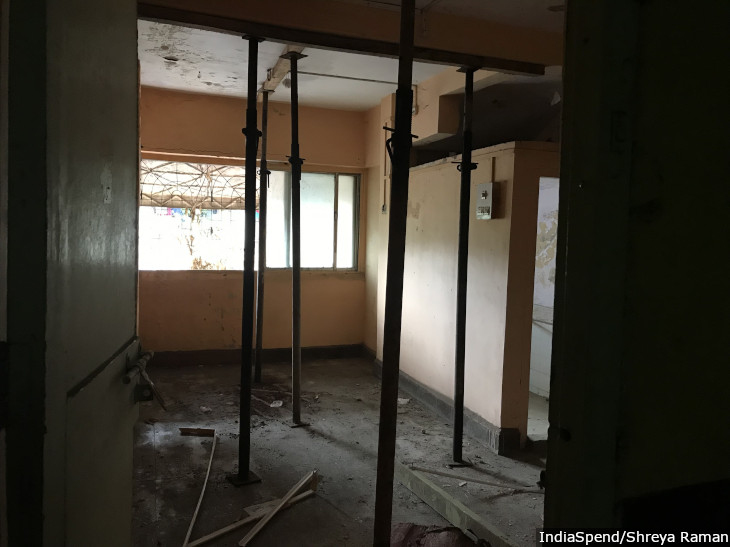
A room in the police housing complex in Saki Naka, Mumbai. The building is now held up by iron rods that were installed two months ago.
The Kamble family has to deal with another problem. “Because of his condition, my husband has to undress to use the toilet,” said Sudha Kamble, “That means the entire family has to leave the house whenever he has to go. We are fine with it but my son will get married next month. How will my daughter-in-law manage?”
‘Last repairs in 2003’
We heard complaints about poor maintenance work in police housing complexes across Mumbai.
The police housing complex and other buildings in Saki Naka were built in 1995 by the Maharashtra Housing and Area Development Authority (MHADA). “The other residential buildings are perfectly fine but the police complex is dilapidated,” said Sawant. “It is because they have not been maintained properly. The last time these buildings saw any repair work was in 2003.”
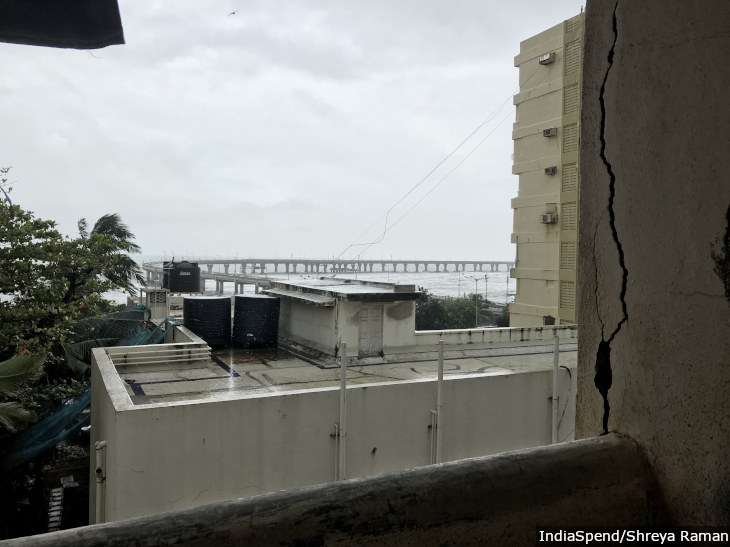
Residents of the sea-facing G block police-department housing complex in Worli have been asked to vacate their homes as the building has developed cracks and is unsafe to live in.
In south Mumbai’s Worli police housing camp, residents of the G block were asked to vacate their homes three months ago as the building was declared too dangerous to inhabit. The only maintenance work ever conducted in this camp was in 2004, said Sanjay Borde*, a head constable, who has been living here since it was constructed in 1978.
Residents of G block here have been asked to move to another block, C, in the same compound which is itself undergoing repairs and has no electricity. “They keep asking us to shift to the other place but how can we, without electricity or water supply?” said Rohit Shinde*, a head constable at the Worli police station.
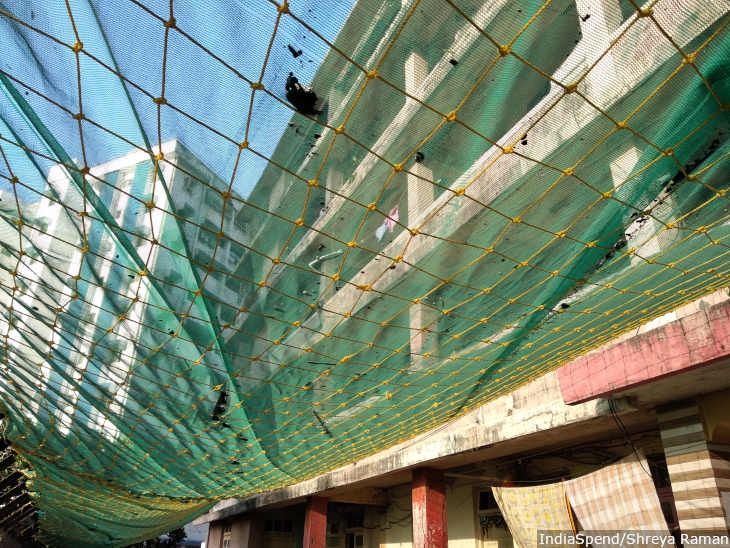
A net has been laid covering the pathway outside G block building in Worli. The net was installed to protect the people who are walking on the pathway from the debris that may fall.
Two years ago, C block residents were asked to move as the building was found to be unsafe. While some left, some stayed back as the building was being repaired.
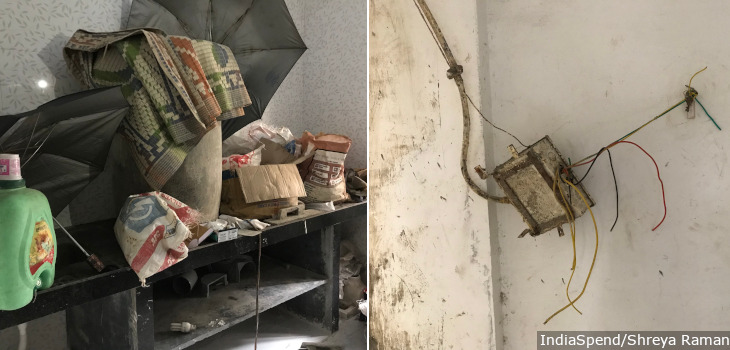
The house allocated to Rohit Shinde* in C block is under repair. The kitchen counter (left) holds the construction material and there is no electricity connection (right).
Each police housing neighbourhood has a line orderly who handles maintenance-related complaints and is expected to take these up with the PWD. “The PWD generally fixes the problem within 15-20 days,” said the line orderly at the Nagpada police housing who did not wish to be named. “Sometimes, it takes longer because of lack of funds.”
Arup Patnaik, former police commissioner of Mumbai and former managing director of the Maharashtra State Police Housing Corporation (MSPHC), blamed the PWD for the poor state of many housing complexes.
“The PWD does a bad job with maintenance,” said Patnaik, “It has many responsibilities and police housing is not in its top priorities. We (MSPHC) had offered to take up the maintenance of the housing. Although PWD has more staff than the housing corporation, we had proposed that we will outsource the job to private entities, which we will oversee. But that did not happen.”
IndiaSpend tried to contact PWD officials through e-mails and phone calls to seek responses to these comments. This story will be updated if and when we receive their responses.
‘I will have to shift my child’s school’
Residents of three blocks in the Saki Naka complex were asked to vacate their homes on June 28, 2019, two weeks after schools reopened. Suresh Mhatre*, who has two children studying in a neighbourhood primary school, does not want to move mid-semester.
“If we had got the notice in January, we could have looked for a different school for our child, arranged everything and could have left after the academic year ends,” said Mhatre, “I want my children to have a good education, so I admitted them into an English medium school. Although it takes a big chunk from my monthly salary of Rs 9,000, I am ready to pay for it.”
Mhatre will also have to pay extra for transport if he shifts his childrens’ school. “What should I do now–educate my children or feed my family?” he asked. “We have been told that our children will be given transportation to their schools, but we cannot take the risk. What if they stop after 1 or 2 months?”
Mhatre and many of the residents said that they will not leave until April 2020 when the academic year ends.
Unaffordable rents elsewhere
The other option available to residents is to relocate to a private flat in the same neighbourhood. But, as we mentioned earlier, the house rent allowance given to the constabulary does not allow for this.
“Many of us are looking for houses in a nearby area called Sangharsh Nagar,” said Kishore, Deepika Sawant’s husband, “But as soon as the flat-owners there heard that we had been served with the eviction notice, they increased their rents from around Rs 3,000 to Rs 8,000.” These Sangharsh Nagar houses are the cheapest option in this area because they were constructed under the slum rehabilitation project, Sawant added.
Renting a house also requires additional initial investment like deposits and brokerage. “In many buildings, they are asking us to pay the entire year’s rent at once,” said Kishore Sawant, “We do not have those kind of savings.”
Also, banks are averse to providing police personnel with housing loans, Sawant said. “Banks are scared that if we fail to repay the loan, they won’t be able to take action against us,” said Sawant, “So, they just don’t give us loans.”
Those looking for livable flats thus had no choice but to move to distant suburbs with affordable rents, but have to struggle with long commutes. Savita Bhosle*, a woman police constable who is posted at the Nagpada police station in southern Mumbai, lives in a rented flat in the eastern suburb of Ambernath, 60 km from her place of work. “Flats in police complexes are very small and in a bad condition,” said Bhosle, “I could only get a house here with the allowance that I get.”
Bhosle spends 3-4 hours each day on commute. Though work hours for police personnel in Mumbai have been limited to eight hours, overtime is routine. Nearly half of the police personnel in India work overtime regularly and 70% of the personnel in Maharashtra work 9-12 hours a day on average, the study by the Azim Premji University and Lokniti found.
“Housing is especially important for the constabulary as higher officials can manage (rent/purchase) with their pay grade,” said former commissioner Patnaik, “For the constabulary, it is either this or living 50-60 km away and travelling 1-2 hours.”
There are plans to redevelop police housing complexes under public-private partnerships, said Patnaik.
“When I was in the corporation, we had increased the size of the houses,” said Patnaik. “The newly constructed buildings have larger rooms for the constabulary. There is no solution for the older houses. The only solution is to redevelop the older buildings into high rises with bigger rooms. And it is happening. In Mulund, they are planning to build a 39-storey building, that will be a first.”
For six months now, IndiaSpend has been waiting for a response from the managing director of the MSPHC but has yet to be given any information about its redevelopment plans. This story will be updated when we get a response.
(*Names have been changed to protect identities)
(Shreya Raman is a data analyst with IndiaSpend.)
Courtesy: India Spend
